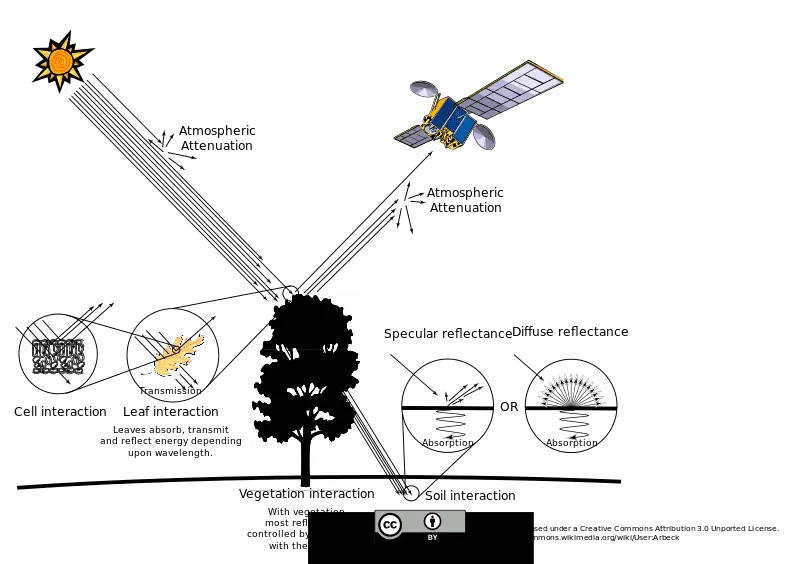5 Types of Electromagnetic Waves and Characteristics Discussed
Types of electromagnetic waves are; ionizing, non-ionizing, low-frequency (LF), high-frequency (HF), and ultra-high frequency (UHF) EM waves. They are distinguished based on mode of interaction and propagation.
This article discusses the types of electromagnetic waves and their characteristics, as follows;
1). Ionizing Electromagnetic Waves (as one of the Types of Electromagnetic Waves)
Ionizing electromagnetic waves; also called ionizing radiation, are energy streams that can cause the loss or gain of electrons in the atomic structure of materials with which they come into contact [7].
The concept of ionizing radiation is very important in modern discussions of nuclear energy management and medical technology.
Ionization by electromagnetic waves works where the waves in question have a high energy exposition, or energy output per second. This is the case for all waves in the electromagnetic spectrum that have high frequencies (and short wavelengths) of propagation.
Three waves in the electromagnetic spectrum are ionizing, which include; Gamma Rays, X-Rays and Ultraviolet Rays. They may also be referred to as examples of ionizing electromagnetic radiation, and are known to have high frequencies compared to other EM waves like radio waves and microwaves.
It must be noted that some studies do not classify ultraviolet radiation as an ionizing electromagnetic wave, because its energy exposition is lower than those of gamma and x-rays.
Prolonged exposure to ionizing electromagnetic waves is generally harmful, and associated with consequences like mutation in plants and animals, significant damage to cells, tissues and organs, and cancer incidence [13].
2). Non-Ionizing Electromagnetic Waves
While ionizing electromagnetic waves are those that are capable of inducing electron loss or gain, non-ionizing waves are those which lack this capability.
Generally, the non-ionizing electromagnetic waves have lower energy exposition, because of a relatively-low range of frequencies. In some studies, these waves are referred to as non-ionizing EMF, simply denoting that they are produced by Electrical and Magnetic Fields.
Examples of non-ionizing EMF are; Visible Light, Infrared Radiation (IR), Microwaves, and Radio Waves. Some studies add Ultraviolet (UV) radiation to this list, because its ionizing properties are far weaker than those of typical ionizing-EM waves.
The non-ionizing nature of EMF radiation means that it is less likely to have some of the hazardous effects attributed to ionizing radiation, like cell and tissue damage, as well as genetic mutation.
This explains the use of these waves for purposes that allow long-term exposure to humans, such as in lighting systems, and wireless communication for smart devices and IoT networks.
However, studies have also shown that overexposure to non-ionizing electromagnetic waves can still have harmful effects, even at very low intensity (EMF) [11]. These effects can be better understood by studying the dangers of radio waves, which are part of the non-ionizing EMF category.
It must be noted that the low frequency of non-ionizing electromagnetic waves does not affect their speed, which is still equivalent to the speed of light (3 × 10^8 m/s).
Below is a table summarizing the ionizing vs non-ionizing electromagnetic waves comparison;
Comparison Criteria | Ionizing Waves | Non-Ionizing Waves |
Energy Exposition | High | Low |
Relative Frequency | High | Low |
Speed | 3 × 10^8 m/s | 3 × 10^8 m/s |
Relative Severity of Effects | High | Low |
Examples | Gamma Rays, X-Rays, Ultraviolet (A, B) Rays | Visible Light, Infrared Rays (IR), Microwaves, Radio Waves |
3). Low-Frequency Electromagnetic Waves (LF) (as one of the Types of Electromagnetic Waves)
Low frequency electromagnetic waves, are also called low frequency radiation; and may be denoted by the abbreviation LFE.
These waves are those that occupy the lower frequency segment or section of the electromagnetic spectrum.
They may be classified into different sub-categories based on their precise range of frequencies, as outlined in the table below (in descending order of frequency);
Low Frequency Wave Sub-Category | Frequency Range |
Low Frequency (LF) Radiation | 30 kHz - 300 kHz |
Very Low Frequency (VLF) Radiation | 3 kHz - 30 kHz |
Ultra Low Frequency (ULF) Radiation | 300 Hz - 3 kHz |
Extremely Low Frequency (ELF) Radiation | 30 Hz - 300 Hz |
Low frequency waves are more widely occurring in the environment, as they can be given off by most charged bodies, due to their low energy exposition [13]. An instance that describes the pervasive nature of low frequency waves is electricity transmission lines, which give off extremely low frequency radiation [5].
It must be recalled that low frequency waves are also non-ionizing; meaning that they pose minimal hazard risk on exposure. Uses of this type of electromagnetic wave include remote sensing, lighting, and communication.

4). High-Frequency Electromagnetic Waves (HF)
For electromagnetic waves, high frequency refers to frequency values that range between 3 and 30 MHz [9].
These waves have a high energy exposition because of the large number of charge-oscillations that occur per unit time.
Gamma rays have the highest frequency as well as the highest ionizing effect and energy exposition, across the entire electromagnetic spectrum. Examples of electromagnetic waves with high frequencies are; Gamma Rays and X-Rays, with Ultraviolet (UV) Radiation sometimes being included.
High frequency electromagnetic waves are used to facilitate the transmission of electrical signals [6], as well as for radiotherapy in medicine.
Because of their high energies, HF waves can cause significant injury on exposure [4].
Very-High Frequency (VHF) electromagnetic waves are another type of waves, whose frequencies range between 30 and 300 MHz [1].
However, they are not among the main types of electromagnetic waves, because they share most of the basic attributes of high frequency waves.
5). Ultrahigh-Frequency Electromagnetic Waves (UHF) (as one of the Types of Electromagnetic Waves)
Ultrahigh Frequency waves (UHF) are electromagnetic waves that range in frequency between 300 MHz and 3 GHz [2].
The key difference between ultrahigh and high frequency electromagnetic waves is that ultrahigh frequency waves have a longer range of wavelength, higher energy exposition and longer attenuation or decay period, all of which make it a more efficient means of data transfer, than high frequency waves.
Unlike high frequency waves that tend to occur naturally, ultrahigh frequency waves are usually produced by intensive EM field excitation, which causes low frequency waves like radio waves, to vibrate with accelerated frequency.
Ultra high frequency electromagnetic waves are used for long-range, fast-transmission communication, such as in cellular communication technology, and television broadcasting.
Examples of ultrahigh frequency radiation are enhanced radio waves for Bluetooth and Wi-Fi data transfers, television broadcasting and cell phone communication.
Compared to un-enhanced radio waves, microwaves and visible light, UHF waves have a much longer attenuation period, and higher energy [3]. Overexposure to this type of radiation through mobile phones has been found to have significant health implications [8].
Other types of electromagnetic waves with higher frequencies than UHF waves include Superhigh frequency (SHF), and extremely-high frequency (EHF) waves. These are similar in basic characteristics, to ultrahigh frequency waves, and cannot be individually distinguished as major types of waves.
Super-High Frequency (SHF) electromagnetic waves range in frequency from 3 GHz to 30 GHz.
Extremely-High Frequency (EHF) electromagnetic waves have frequencies that range between 30 GHz and 300 GHz [10].

Conclusion
Types of electromagnetic waves are;
1. Ionizing Electromagnetic Waves
2. Non-Ionizing Electromagnetic Waves
3. Low-Frequency Electromagnetic Waves (LF)
4. High-Frequency Electromagnetic Waves (HF)
5. Ultrahigh-Frequency Electromagnetic Waves (UHF)
References
1). Adekola, S. A.; Victor, A. (2017). "On the electromagnetic characteristics of dipole antennas at MF/HF/VHF/UHF." 2017 IEEE 3rd International Conference on Electro-Technology for National Development (NIGERCON). Available at: https://doi.org/10.1109/NIGERCON.2017.8281881. (Accessed 31 March 2023).
2). Agostini, M.; Cecchini, M. (2021). "Ultra-high-frequency (UHF) surface-acoustic-wave (SAW) microfluidics and biosensors." Nanotechnology. 2021 May 10;32(31). Available at: https://doi.org/10.1088/1361-6528/abfaba. (Accessed 31 March 2023).
3). Chen, Y. S.; Zhao, Y.; Beinat, C.; Zlitni, A.; Hsu, E. C.; Chen, D. H.; Achterberg, F.; Wang, H.; Stoyanova, T.; Dionne, J.; Gambhir, S. S. (2021). "Ultra-high-frequency radio-frequency acoustic molecular imaging with saline nanodroplets in living subjects." Nat Nanotechnol. 2021 Jun;16(6):717-724. Available at: https://doi.org/10.1038/s41565-021-00869-5. (Accessed 31 March 2023).
4). Ciano, M.; Burlin, J. R.; Pardoe, R.; Mills, R. L.; Hentz, V. R. (1981). "High-frequency electromagnetic radiation injury to the upper extremity: local and systemic effects." Ann Plast Surg. 1981 Aug;7(2):128-35. Available at: https://doi.org/10.1097/00000637-198108000-00009. (Accessed 31 March 2023).
5). Cios, A.; Ciepielak, M.; Stankiewicz, W.; Szymański, Ł. (2021). "The Influence of the Extremely Low Frequency Electromagnetic Field on Clear Cell Renal Carcinoma." Int J Mol Sci. 2021 Jan 29;22(3):1342. Available at: https://doi.org/10.3390/ijms22031342. (Accessed 31 March 2023).
6). D'Agostino, S.; Della Monica, C.; Palizzi, E.; Di Pietrantonio, F.; Benetti, M.; Cannatà, D.; Cavagnaro, M.; Sardari, D.; Stano, P.; Ramundo-Orlando, A. (2018). "Extremely High Frequency Electromagnetic Fields Facilitate Electrical Signal Propagation by Increasing Transmembrane Potassium Efflux in an Artificial Axon Model." Sci Rep. 2018 Jun 18;8(1):9299. Available at: https://doi.org/10.1038/s41598-018-27630-8. (Accessed 31 March 2023).
7). Gao, Y.; Zheng, Y.; Sanche, L. (2021). "Low-Energy Electron Damage to Condensed-Phase DNA and Its Constituents." Int J Mol Sci. 2021 Jul 23;22(15):7879. Available at: https://doi.org/10.3390/ijms22157879. (Accessed 31 March 2023).
8). Moradi, M.; Naghdi, N.; Hemmati, H.; Asadi-Samani, M.; Bahmani, M. (2016). "Effects of the Effect of Ultra High Frequency Mobile Phone Radiation on Human Health." Electron Physician. 2016 May 25;8(5):2452-7. Available at: https://doi.org/10.19082/2542. (Accessed 31 March 2023).
9). Ndao, P. M.; Erhel, Y.; Lemur, D.; Le Masson, J. (2011). "Design of a high-frequency (3–30 MHz) multiple-input multiple-output system resorting to polarisation diversity." 2011IET Microwaves Antennas & Propagation 5(11):1310 - 1318. Available at: https://doi.org/10.1049/iet-map.2010.0165. (Accessed 31 March 2023).
10). Pinhasi, Y.; Yahalom, A.; Harpaz, O.; Vilner, G. (2004). "Study of Ultrawide-Band Transmission in the Extremely High Frequency (EHF) Band." IEEE Transactions on Antennas and Propagation 52(11):2833 - 2842. Available at: https://doi.org/10.1109/TAP.2004.835121. (Accessed 31 March 2023).
11). Saliev, T.; Begimbetova, D.; Masoud, A. R.; Matkarimov, B. (2019). "Biological effects of non-ionizing electromagnetic fields: Two sides of a coin." Prog Biophys Mol Biol. 2019 Jan;141:25-36. Available at: https://doi.org/10.1016/j.pbiomolbio.2018.07.009. (Accessed 31 March 2023).
12). Tuieng, R. J.; Cartmell, S. H.; Kirwan, C. C.; Sherratt, M. J. (2021). "The Effects of Ionising and Non-Ionising Electromagnetic Radiation on Extracellular Matrix Proteins." Cells. 2021 Nov 5;10(11):3041. Available at: https://doi.org/10.3390/cells10113041. (Accessed 31 March 2023).
13). Wyszkowska, J.; Shepherd, S.; Sharkh, S.; Jackson, C. W.; Newland, P. L. (2016). "Exposure to extremely low frequency electromagnetic fields alters the behaviour, physiology and stress protein levels of desert locusts." Sci Rep. 2016 Nov 3;6:36413. Available at: https://doi.org/10.1038/srep36413. (Accessed 31 March 2023).


